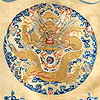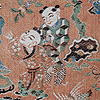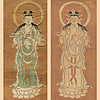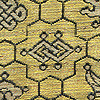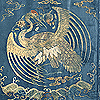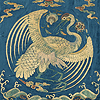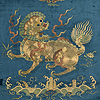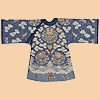 |
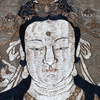
3163
An Important Early Ming Dynasty Silk & Gold Thankga
Guanyin with Dragon and Luohan subduing a Dragon, Tiger, Qilin, Elephant,
Circa 1500 A.D.
Ming Dynasty
1368-1644 A.D
Size 89" x 76"
Size 230 x 200 cm
Below are Detail
Images
Guanyin or Guan Yin is the most commonly used Chinese translation of the Bodhisattva known as Avalokitesvara Guanyin is the Buddhist bodhisattva associated with compassion. In the East Asian world, Guanyin is the equivalent term for Avalokitesvara Bodhisattva. Guanyin also refers to the bodhisattva as adopted by other Eastern religions. She was first given the appellation of "Goddess of Mercy" or the Mercy Goddess by Jesuit missionaries in China. The Chinese name Guanyin is short for Guanshiyin, which means "[The One Who] Perceives the Sounds of the World.
Some Buddhists believe that when one of their adherents departs from this world, they are placed by Guanyin in the heart of a lotus, and then sent to the western Pure land of Sukavati. Guanyin is often referred to as the "most widely beloved Buddhist Divinity with miraculous powers to assist all those who pray to her, as is said in the Lotus Sutra and Karandavyuha Sutra.
Several large temples in East Asia are dedicated to Guanyin including Shitenno-ji, Senso-ji, Kiyomizu-dera, Sanjusangen-do, Shaolin, Dharma Drum Mountain and many others. Guanyin's abode and Bodhimanda in India is recorded as being on Mount Potalaka. With the localization of the belief in Guanyin, each area adopted their own Potalaka. In China, Putuoshan is considered the bodhimanda of Guanyin. Naksansa is considered to be the Potalaka of Guanyin in Korea. Japan's Potalaka is located at Fudarakusan-ji. Tibet's Potalaka is the Potala Palace. There are several pilgrimage centers for Guanyin in East Asia. Putuoshan is the main pilgrimage site in China. There is a 33 temple Guanyin pilgrimage in Korea which includes Naksansa. In Japan there are several pilgrimages associated with Guanyin. The oldest one of them is the Saigoku Kannon Pilgrimage, a pilgrimage through 33 temples with Guanyin shrines. Guanyin is beloved by all Buddhist traditions in a non-denominational way and found in most Tibetan Temples under the name Chenrezig. Guanyin is also beloved and worshiped in the temples in Nepal. The Hiranya Varna Mahavihar located in Patan is one example. Guanyin is also found in some influential Theravada temples such as Gangaramaya, Kelaniya and Natha Devale nearby Sri Dalada Maligawa in Sri Lanka; Guanyin can also be found in Thailand's Temple of the Emerald Buddha, Wat Huay Pla Kang (where the huge statue of her is often mistakenly called the "Big Buddha") and Burma's Shwedagon Pagoda. Statues of Guanyin are a widely depicted subject of Asian art and found in the Asian art sections of most museums in the world.
More Information Below
Asian
Textile History
Kesi (simplified Chinese) 缂丝 traditional Chinese 緙絲 pinyin kèsī K'o-ssu in Wade-Giles is a technique in Chinese silk tapestry. It is admired for its lightness and clarity of pattern. At first, this technique was chiefly used to protect scrolls containing paintings. It was also employed as a support for paintings, later going on to become an esteemed art form. This art form especially flourished between the eleventh and thirteenth centuries.
The Sogdians from Central Asia during the mid-1st millennium brought their art and technique of textile tapestry to China (the Sogdians established flourishing communities throughout, and by the 6th century, their textile patterns were already being seen in China, and it is through this Silk Road influence, resulted in what became known as "kesi". During the Song dynasty, the art of the "kesi" reached its height.
It is a tapestry weave, normally using silk on a small scale compared to European wall-hangings. Clothing for the court was one of the main uses. The density of knots is typically very high, with a gown of the best quality perhaps involving as much work as a much larger European tapestry. Initially used for small pieces, often with animal, bird and flower decoration, or dragons for imperial clothing, under the Mind Dynasty it was used to copy paintings.
"Kesi" means "cut silk", as the technique uses short lengths of Weft thread that are tucked into the textile. Only the weft threads are visible in the finished fabric. Unlike continuous weft brocade in
k'o-ssu each colour area was woven from a separate bobbin, making the style both technically demanding and time-consuming.
Kesi first appeared during the Tang dynasty (618–907), and became popular in the Southern Song dynasty (1127–1279), reaching its height during the Ming dynasty (1368–1644). The style continued to be popular until the early 20th century, and the end of the Qing dynasty in 1911–12

|
An Important Early Ming Dynasty Thangka

Mahaprajapati or Kalidimu Guizi Mushen
Mahaprajapati Gautami was the aunt and foster mother of prince Siddhartha. She raised him after the death of her sister, the Buddha’s mother: Mayadevi. The meaning of the Sanskrit name Mahaprajapati is “The great patroness of all beings” and Gautami is the female equivalent of Gautama, the family name of prince Siddhartha. After she was ordained as a Buddhist nun (Skt. bhikshuni) by the Buddha, she accepted the name of Mahaprajapati Bhikshuni.
The story of Mahaprajapati is mentioned in several biographies of Buddha Shakyamuni, mainly in regard to the time after his enlightenment. Very little information is available about the early stage of her life, before becoming the foster mother of prince Siddhartha, and also regarding the period of his upbringing. After Shakyamuni attained enlightenment and founded the Buddhist monastic community, Mahaprajapati begged him to be allowed to join. Initially, he rejected her wish to be ordained as a nun. Later his disciple Ananda persuaded him that in spiritual matters women are on a par with men and should have equal opportunities to follow the path to enlightenment.
The Buddha agreed with his trusted follower and ordained Mahaprajapati as the first Buddhist nun along with several women from Shakya Dynasty, who shared her aspirations. The traditional account states that after leaving her home and family, Mahaprajapati established an order of Buddhist nuns. Her goal was to create an organization, which will assist women in following the Buddhist path on their way to enlightenment. Therefore, the aunt of the Buddha not only became the first Buddhist nun, but also the first woman to head a Buddhist female monastic order. She is traditionally considered to be the “mother” of the Buddhist order of nuns, much in the same way that Shakyamuni is respected as the founder of the order of monks.
Following the example of Mahaprajapati, large numbers of women left their homes in order to devote their lives to Dharma and to the abidance to a strict code. The community of nuns flourished under the leadership of Mahaprajapati and thousands of women achieved the state of arhat by purifying their minds and attaining liberation from the suffering of countless births.
The Buddha preached the path of mental purification, which, according to the Buddhist teaching, is equally effective for men and women alike. Theoretically, women have the same potential to achieve liberation, but probably owing to the then patriarchal society, discipline among nuns is much stricter in comparison to that of the monks. Mahaprajapati had to accept eight special rules, which place bhikshuni in a subordinate position to the order of monks. With the development of the Sangha of bhikshuni they were obliged to abide to about a hundred rules more than the monks. Nevertheless, nuns had their own rights as well, separately from the monks, such as the opportunity to elect new members of their order and to make independent decisions.
The independent life of Buddhist nuns offered a new form of social freedom to women at the time of the Buddha. Dedication to the Buddhist practice became a method not only for attaining spiritual liberation, but also for achieving freedom from the hardships of family life. At that time the obligations of married woman included complete subordination to her husband, bearing a number of children and laborious household chores.
At the age of one hundred and twenty Gautami alone decided to leave this world, which confirmed her high spiritual accomplishment. She carefully prepared her disciples who, at the time, numbered more than five hundred nuns and plenty of laywomen. In her last sermon she convinced them to follow devotedly the path of renouncing worldly vanity and describes her achievements.
Shortly before her passing away, she went to the Buddha and acknowledged her great debt to him as well as her determination to attain complete liberation. He encouraged her to demonstrate her supernatural powers in order to disperse the doubts of those who claimed that women could not perceive the final truth. What is truly remarkable about her death is that she was followed by five hundred nuns, who chose to leave the world together with her. Due to her support they achieved supreme spiritual realization and acquired the ability to pass consciously into another dimension of existence, following their spiritual leader.
|
 |
